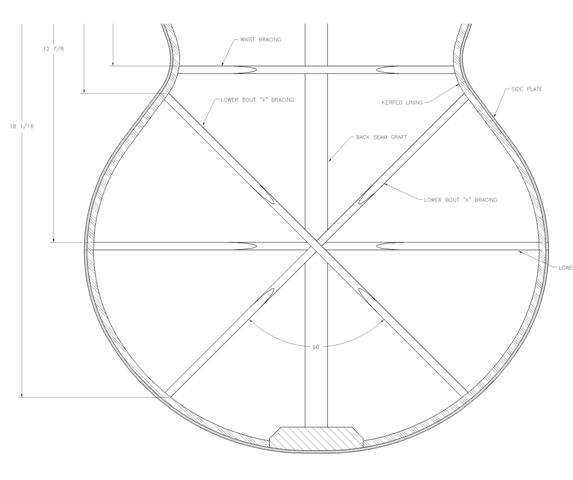Thanks for the input guys.
Ron, I too , have used the two wide lower braces, but wonder if I'm missing out on some available bass responce because of it. Benedetto says he acheives a larger bass with the lighter back ,but if it's too light ,his treble suffers.
Thanks for your plan Michael. A very cool looking brace set up. What dimensions are those (star) braces ,and what is your back thickness. I can clearly see why this bracing type would have the guitar project more , as it would lesson the back's movement . Have you noticed any less bass reponse with this firmer back ?
Like Michael McBroom, I find guitars with a heavily braced back ( read inert) ,to be cold and a little lifeless to the player. Just can't feel that thump on your chest when your've hit low "E" ! , but realise there is more projection out front.
It would seem that a looser back would slow down the air movement as it is cushioned, and thereby give more of a bass response but to the detriment of volume , and perhaps treble. I guess there is a balance one has to arrive at by way of volume/projection verses tonal response ??
Thanks also to Mr. Carruth . How do you arrive at having your back a semitone higher than the top 'main mode" I.m guessing you start off with an initial back thickness and thin down the braces until you reach your desired resonance . What thickness do you start off with?
I have discovered that a ladder braced back built to Cumpiano's dimensions ( 2.8m.m.thick,,,.11 ") delivers a main back resonance at least a semitone lower than the main top resonance . On checking a Martin Auditorium , the back resonance was higher,,,,, a lot higher. I found it lacking in the bass dept.
Your input and views/ suggestions are very much appreciated.
Regards, Craig Lawrence
|

 ) the shortest (and probably the lightest) brace you can put on the back is one that is straight across from side to side.
) the shortest (and probably the lightest) brace you can put on the back is one that is straight across from side to side.